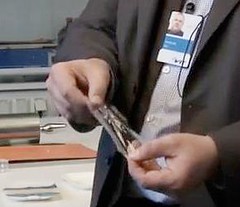 芬蘭已開發出一項新技術,塑料包裝產業轉而生產「生質基質產品」(bio-based products),降低對石油製塑料產品的依賴。
芬蘭已開發出一項新技術,塑料包裝產業轉而生產「生質基質產品」(bio-based products),降低對石油製塑料產品的依賴。
「生質基質」材料有別於目前廣泛使用的石油基質塑料,是運用生物可分解與可再生的特性,以生物質為基底,所研發出來的材料,常稱為生物可分解塑膠。
該研究首席科學家日前宣布,芬蘭VTT國家技術研究中心(VTT Technical Research Centre of Finland)已研發出一種新技術,能提高生質基質包裝產品的品質。
VTT是北歐最大的技術研發機構之一,隸屬芬蘭就業與經濟部(Ministry of Employment and the Economy)。該機構生物技術與食品研究實驗室教授Ali Harlin表示,VTT的技術使生質基質產品不只在生態性方面優於傳統包裝用料,在產品品質上亦然。關鍵在於PGA(Polyglycolide, Polyglycolic acid,聚乙醇酸)聚合物。
Harlin已開發出一種技術,能比以往更有效率地從生質基質材料中,產出PGA聚合物之單體:乙醇酸(glycolic acid)。
Harlin表示,以糖類製造出的PGA塑料,具有良好的阻隔性。以膜來說,它是已知最有效的氧氣阻絕物,將可有效防止食物受到氧的破壞。
除了強度和耐熱性,包裝塑料也需要氣密、防潮與耐油。添加PGA聚合物於傳統包裝塑料中,將可顯著提高這些特性。
當PGA膜被用來包裝食品,它會將氧隔絕,創造出了Harlin所謂的「調整空氣包裝」(modified atmosphere package),在包裝內形成保護性氣層,而在包裝外的氧將無法破壞食物。
新一代的生質基質包裝塑料,不僅無害生態(eco-friendly),且相對於過去的包裝塑料,亦有卓越的品質表現。
 Harlin解釋,PGA塑料的強度,比現在市場上最常見的可生物分解塑料PLA(Polylactic acid, polylactide,聚乳酸)強20%到30%,且能承受的溫度更比PLA還要高出20度(攝氏度)。
Harlin解釋,PGA塑料的強度,比現在市場上最常見的可生物分解塑料PLA(Polylactic acid, polylactide,聚乳酸)強20%到30%,且能承受的溫度更比PLA還要高出20度(攝氏度)。
同時,PGA塑料也比PLA更快分解,而如果有必要,它的生物降解性也是可調控的。
Harlin表示,這樣的糖基塑料托盤是可回收再利用的,托盤和上面的包裝膜都可再次分解成它的原始物料:糖。
每年世界石油總消費量約有5%是用來生產塑料,而有40%的塑料用於包裝;因此,包裝業承受不少的壓力,受期待要走出對石油的依賴。也由於「倫理消費」的理念與相關法規開始興起,促使包裝業必須設法尋求符合永續發展的轉型。目前,生質基質塑料約佔全球塑料產品的1%。
VTT表示,依據產品生命週期分析,製造生質基質塑料的二氧化碳排放量,僅為以石油為原料之塑料的70%。
使用VTT的新技術,可讓塑料包裝業走向全生質基質化,並使食品包裝業對石油的依賴性越來越低。
在工業中使用可再生的天然資源,可減少對石油的依賴以及消費行為的碳足跡。這樣的轉變將有助於歐盟實現其2050年目標:減低至少80%之1990年溫室氣體排放量。
VTT研究員在評估芬蘭是否有機會達到80%溫室氣體減排目標後表示,這將是艱難的一仗,但只要所有生產或消耗能量單位共同參與,它是有可能實現。
A new technology developed in Finland is enabling the plastic packaging industry to shift toward bio-based products, away from dependence on plastics made from petroleum.
The VTT Technical Research Centre of Finland has developed a new technique to improve the quality of bio-based plastic packaging, the project’s lead research scientist announced Tuesday.
With VTT’s technology, bio-based plastic packages will outperform traditional packaging materials not just ecologically but also in terms of quality. The key element is PGA polymer, says professor Ali Harlin from VTT’s biotechnology and food research laboratory.
Harlin has developed a technique that enables the production of the PGA monomer glycolic acid from bio-based materials more efficiently than ever before.
Made from sugar, PGA plastic has excellent barrier properties, Harlin says. As a film, it is the most efficient oxygen barrier known, and it will effectively keep food from spoiling, which is what happens to food in the presence of oxygen.
In addition to strength and heat resistance, plastic packaging also needs to be airtight, vapor-proof and grease-resistant. Adding PGA into the structure of traditional plastic packaging significantly improves these qualities, says Harlin.
When PGA film is used to package food, it keeps the oxygen out of the package, creating what Harlin calls a “modified atmosphere package.” There is a protective atmosphere inside the package and the oxygen is outside where it cannot damage the food.
The new generation of bio-based plastic packaging is not only eco-friendly but also has several superior qualities compared to conventional plastic packaging.
PGA plastic is between 20 and 30 percent stronger than PLA – the most popular biodegradable plastic on the market – and able to withstand temperatures 20 degrees Celsius higher, Harlin explains.
It also breaks down more quickly than PLA, but its biodegradability can be regulated if necessary, Harlin said.
Sugar-based plastic food trays are recyclable and Harlin says the trays and films can be broken down into their raw material, sugar, again.
The volume of oil used every year in the production of plastics equates to approximately five percent of the world’s total oil consumption.
Approximately 40 percent of all plastics are used in packaging, which puts special pressure on the packaging industry to reduce its dependence on oil.
Ethical consumption principles and legislative changes are steering the packaging industry towards sustainable development. At the moment, bio-based plastic accounts for approximately one percent of global plastic production.
According to lifecycle analyses, carbon dioxide emissions from bio-based plastics can be as much as 70 percent lower than from oil-based plastics, says VTT, a state-owned research institute operating under Finland’s Ministry of Employment and the Economy.
Using the new VTT technology, the plastic packaging industry is moving towards completely bio-based products and is beginning to provide the products that will allow the food packaging industry to become less and less dependent on oil.
The use of renewable natural resources in industrial applications reduces dependence on oil and the carbon footprint attributable to consumption, so the shift to bio-based plastic will help the European Union meet its goal for 2050 – to reduce greenhouse gas emissions by at least 80 percent from the level of 1990.
VTT specialists who have assessed Finland’s chances of achieving the 80 percent greenhouse gas emission reduction targets say the goal is a tough one for Finland, but it is possible to achieve as long as all sectors that produce or consume energy take part.
※ 全文及圖片詳見:ENS


